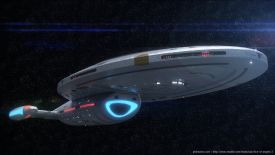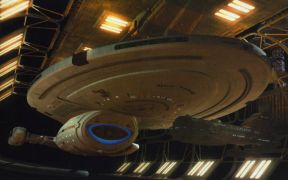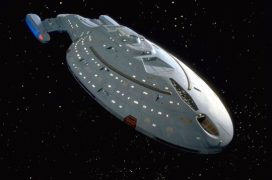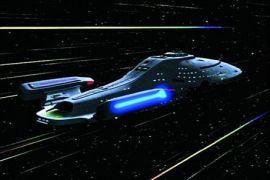Intrepid Class
More actions

| |
| Intrepid-class | |
| Class Information | |
| Role: | Explorer / Light Cruiser |
| Status: | |
| Date Entered Service: |
2370 |
| Basic Stats | |
| Decks: |
15 |
| Cruising Speed: |
Warp 7 |
| Total Compliment: |
175 |
| Tactical Systems | |
| Energy Weapons: | |
| Torpedo Launchers: |
4 Launchers |
| Shields: | |
Class Description
In 2370 a new class of ship entered service in Starfleet. The ship would be, when commissioned, the fastest class of starship in service within any fleet. She would be classed as a frigate/light explorer/scout ship. She would also be well-armed, manoeuvrable, well protected, and posses a sensor suite comparable to the Galaxy Class'. The ship featured a unique warp nacelle design, which allowed the nacelles to pivot up when in warp flight, thereby improving the warp field. The class was also the first to use bioneural gel packs in the computer systems.
Starfleet's shipbuilding policy of the last century had emphasized ever larger, more capable designs. These designs were capable of carrying out a wide variety of missions within a single hull, and many times with multiple missions happening simultaneously. However, this has led to a gradual fall in the numbers of vessels that can be fielded. Where the Excelsior Class numbered in the hundreds, the Ambassadors were limited to a production run of twenty-six, and the Galaxy Class to six ships initially. While the exploration capacity of these classes was still sufficient to meet the tasks demanded of them, the lack of numbers had led to certain restrictions in flexibility. Losses among the Galaxy Class had also emphasized that placing "all the eggs in one basket" was not necessarily the wisest choice.
The Intrepid design was fielded partly to correct this situation. The design requirement, issued in 2358, called for a vessel in the 360-meter range with a volume some 15% that of a Galaxy Class. Although the limited size meant that the vessel would have much lower overall capabilities than the Galaxy Class, this was to be, in some part, offset by the use of the latest technology. The ship’s computer system would be the most advanced model in service; the increased automation this afforded combined with a new generation of sensor equipment would allow the Intrepid Class almost 70% of the scanning and analysis capabilities of a Galaxy Class starship.
Diplomatic functions would be more problematic. Hosting such functions requires supporting large numbers of extra personnel, and the Intrepid Class simply would not have the room for this. Her diplomatic capabilities are therefore limited to relatively small events generally involving Federation negotiations with a single party.
The Intrepid's combat role was also somewhat limited by her size; unable to carry large numbers of torpedoes or high power phaser banks, Starfleet settled on a scouting and support mission for the ship. Fitted out with type-IX phaser arrays and single fire torpedo tubes standard. The Intrepid would be capable of engaging vessels the size of a K't'inga Class Battle Cruiser or Galor Class Destroyer one-on-one.
Her high speed and manoeuvrability, combined with the advanced sensor system, would also make her a perfect platform to conduct long-range reconnaissance missions ahead of fleet operations. Within a major fleet battle the Intrepid would also act in support of larger ships, harrying enemy fleet units and drawing fire away from larger Federation ships.
Development of the Intrepid Class went relatively smoothly in the early and mid stages. However, a major problem arose in 2370. It was discovered that the energy emissions of standard warp drives caused considerable cumulative damage to the structure of subspace. Starfleet called for all designs then in progress to be modified to eliminate this effect, and it was decided to use the Intrepid Class as a test bed for this technology.
After some experimentation it was found that the effect could be avoided by using a warp field with a much-elongated Z-axis, combined with complex warp field modulation and the utilization of new materials during the manufacture of warp coils. This has led to the ship’s saucer section having the forward ellipse becoming common on Federation designs of the period. The new type 9 warp core installed on these vessels made them the fastest vessel in Starfleet's inventory at the time. With a max warp speed of 9.975 the Intrepid Class quickly became one of the fastest ships in the quadrant.
One feature unique to the Intrepid Class, among Federation Starships of this size, was the ability to land on a planetary surface. This feature had been incorporated after several incidents in which transporters and shuttlecraft have been unable to operate through exotic environmental conditions during evacuations or other surface related operations.
The program suffered a serious setback when the USS Voyager, second in the class, was apparently lost on her first mission. Building was suspended on the class while the designs were subjected to intense scrutiny. After a year, without results, the Intrepid project was resumed.
It was later discovered that Voyager had in fact been displaced to the other side of the galaxy, to the Delta Quadrant. The return of Voyager showcased the success of the Intrepid Class, but also noted improvements that would need to be made as well.
Voyager's encounters with multiple different species unique to the Delta quadrant gave Starfleet a vast new array of information to analyse. Amazed at Voyager's survivability, Starfleet Command assigned a team of engineers to specifically break down and replicate the upgrades that Voyager acquired over the years.
Starfleet attempted to duplicate the Borg upgrades to Voyager in an effort to increase the combat effectiveness of other Intrepids but failed, as the Starfleet modifications required more power and more space than the Borg's did. Using data collected from the crew's own modifications, Starfleet increased the overall power flow, shield regeneration time, and impulse drive efficiency.
As with many vessels at the time, the Intrepid Class vessels were slotted for holoemitters to be placed throughout the entirety of the ship. The team came to the realization that these vessels were going to see more combat than the original specifications called for, and would therefore require the capability for the EMHs to go wherever was needed.
The type IX phaser banks originally installed were replaced with type X arrays, giving the vessel a better way to defend itself.
After two years of constant work, the Voyager Upgrade team completed their work, and the newly modified upgrades were installed on the first Intrepid to dock for refits. The results were so impressive, that all current Intrepids were recalled to starbases and dry docks for the refits. Any Intrepid built from that point forward would have the upgrades equipped as standard equipment.
Over all, the Intrepid class was deemed a success, and became a common sight within the fleet.
Images
-
USS Intrepid underconstruction
-
USS Ranger on patrol
-
USS Voyager travailing at warp speeds
Ship Specifications
| Specifications | |||
|---|---|---|---|
| Basic Information |
|
Crew Complement |
|
| Propulsion |
|
Offensive Systems |
ENERGY WEAPONS 13x Type-X Phaser Arrays TORPEDO LAUNCHERS
PAYLOAD |
| Defensive Systems |
|
Primary Systems |
Isolinear/bio-neural computer systems
2 six person transporters
|
| Auxiliary Craft |
SHUTTLEBAYS: 1
|
Other |
STARSHIP FEATURES:
|
| Notes | |||
Deck Listing
| Deck | Details | Deck | Details | |
|---|---|---|---|---|
| Deck 1 |
|
Deck 2 |
| |
| Deck 3 |
|
Deck 4 |
| |
| Deck 5 |
|
Deck 6 |
| |
| Deck 7 |
|
Deck 8 |
| |
| Deck 9 |
|
Deck 10 |
| |
| Deck 11 |
|
Deck 12 |
| |
| Deck 13 |
|
Deck 14 |
| |
| Deck 15 |
| |||
| Federation Ship & Station Classes | |
|---|---|
| Starships | • Akira Class • Antares Class • Century Class • Defiant Class • Galaxy Class • Insignia Class • Luna Class • Nebula Class • Nova Class • Prometheus Class • Saber Class • Steamrunner Class • Sovereign Class • Vesta Class • |
| Starbases | • Argus Class • Aurora Class • Regula Class • Sigma Class • Spacedock Class • |
| Support Craft | Shuttles • Type 8 Shuttle • Type 9 Shuttle • Type 11 Shuttle • Type 15 Shuttlepod • Runabouts • Argo Class • Danube Class • Fighters • Gryphon Class • Other • Workbee • |
Use of Bravo Fleet's Intrepid Class is used under the Creative Commons 4.0 License and may have been modified for AioRPG.



